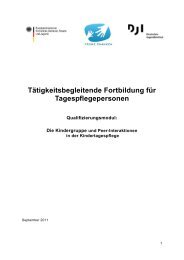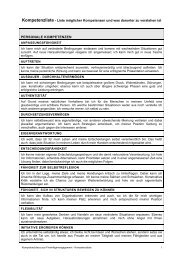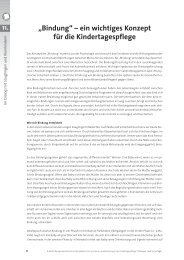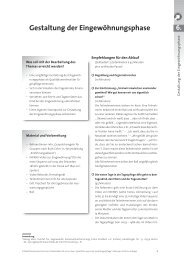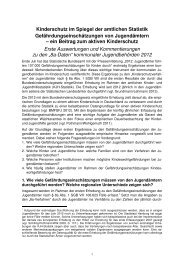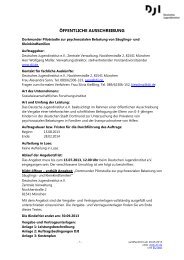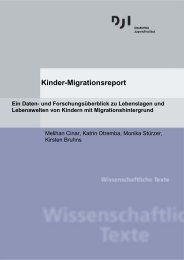download - Deutsches Jugendinstitut e.V.
download - Deutsches Jugendinstitut e.V.
download - Deutsches Jugendinstitut e.V.
Create successful ePaper yourself
Turn your PDF publications into a flip-book with our unique Google optimized e-Paper software.
Dr. Susann Burchardt, Dr. Heike Förster, Tatjana Mögling<br />
Integration strategies for disadvantaged children and<br />
young persons – the welfare state context and specific<br />
influential programme and problem factors<br />
As underlined in the introduction, the general conditions for the development and<br />
implementation of support programmes and strategies for disadvantaged children and<br />
young persons in European countries are characterised by the relevant welfare state<br />
context. This context influences the underlying social aims, orientation and evaluation of<br />
these strategies within the framework of social and youth policy efforts and the qualitative<br />
extent of support and integration opportunities for disadvantaged children and young<br />
persons. Support strategies differ depending on whether it is chiefly welfare-oriented<br />
characteristics which dominate social and youth policy, i.e. the provision of benefit<br />
payments, or activating elements, i.e. the guarantee of chances and opportunities for<br />
disadvantaged children and young persons and their families. A wide range of social<br />
resources are implemented in the programmes according to the dominating form of<br />
welfare-state orientation in individual countries. In South-Eastern European countries for<br />
example, a focus on family-related resources is more probable, as welfare on the part of the<br />
family is a central issue in the prevalent welfare orientation of these countries.<br />
It can also be assumed that the socialistic roots of state welfare orientation in Eastern<br />
and Southern European countries also exert an influence on relevant national programmes<br />
such as the integration of ethnic minorities. Intensely welfare-oriented and also paternalistic<br />
influences are more probable than in strongly individualistically oriented, economically<br />
liberal countries such as Great Britain.<br />
On the basis of Esping-Andersen und Holtmann (Esping-Anderson 1990, Holtmann<br />
2006) and extended to include the new Eastern European EU member states, the<br />
participating EU countries can be categorised according to their fundamental and<br />
historically developed welfare state orientation as follows:<br />
Portugal<br />
Italy<br />
Conservation of<br />
status, oriented<br />
towards professions<br />
and employment<br />
Germany<br />
France<br />
Central welfare state characteristics<br />
Family-oriented Employment-oriented<br />
welfare social security system,<br />
organisation, strong social<br />
pronounced associations,<br />
welfare aspects pronounced welfare<br />
of family-related orientation;<br />
benefits for the subsidiarity<br />
needy;<br />
subsidiarity<br />
Great Britain<br />
Ireland<br />
Pronounced<br />
orientation<br />
towards<br />
voluntary,<br />
market-based,<br />
organised aid for<br />
the needy<br />
Familyoriented<br />
Economicliberal<br />
Socialdemocratic<br />
Scandinavian<br />
states – not<br />
represented<br />
Strong social<br />
state<br />
responsible for<br />
social security,<br />
civil rights<br />
Former<br />
Socialist<br />
countries<br />
Lithuania,<br />
Poland,<br />
Hungary, Czech<br />
Republic<br />
Stateorganised<br />
aid<br />
benefits;<br />
development of<br />
welfare-stateorientation<br />
still<br />
possible<br />
108



